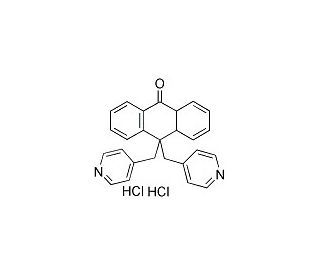

XE 991 dihydrochloride (CAS 122955-42-4)
QUICK LINKS
XE 991 dihydrochloride has garnered attention in neuropharmacological research due to its role as a potent blocker of Kv7 (KCNQ) potassium channels. Studies involving this compound are critical for unraveling the electrophysiological properties of these channels and their significance in neuronal excitability. Researchers utilize XE 991 dihydrochloride to dissect the contributions of Kv7 channels to various neuronal circuits, which is essential for understanding their function in the central nervous system. The compound′s specificity and efficacy in inhibiting Kv7 channels enable detailed analysis of channel behavior, offering valuable insights into the modulation of electrical signaling in neurons. Furthermore, its impact on cellular models of excitability is being examined to ascertain how Kv7 channel dysregulation may affect cellular communication, with broader implications for the understanding of nervous system conditions.
XE 991 dihydrochloride (CAS 122955-42-4) References
- Molecular basis for differential sensitivity of KCNQ and I(Ks) channels to the cognitive enhancer XE991. | Wang, HS., et al. 2000. Mol Pharmacol. 57: 1218-23. PMID: 10825393
- KCNQ/M currents in sensory neurons: significance for pain therapy. | Passmore, GM., et al. 2003. J Neurosci. 23: 7227-36. PMID: 12904483
- Characterization of M-current in ventral tegmental area dopamine neurons. | Koyama, S. and Appel, SB. 2006. J Neurophysiol. 96: 535-43. PMID: 16394077
- Activation of P2Y1 nucleotide receptors induces inhibition of the M-type K+ current in rat hippocampal pyramidal neurons. | Filippov, AK., et al. 2006. J Neurosci. 26: 9340-8. PMID: 16957090
- N-(6-chloro-pyridin-3-yl)-3,4-difluoro-benzamide (ICA-27243): a novel, selective KCNQ2/Q3 potassium channel activator. | Wickenden, AD., et al. 2008. Mol Pharmacol. 73: 977-86. PMID: 18089837
- Fasting and 17β-estradiol differentially modulate the M-current in neuropeptide Y neurons. | Roepke, TA., et al. 2011. J Neurosci. 31: 11825-35. PMID: 21849543
- An antinociceptive role for substance P in acid-induced chronic muscle pain. | Lin, CC., et al. 2012. Proc Natl Acad Sci U S A. 109: E76-83. PMID: 22084095
- Flupirtine inhibits calcitonin-gene related peptide release from rat brainstem in vitro. | Tringali, G., et al. 2012. Neurosci Lett. 506: 332-5. PMID: 22155095
- Vasorelaxation by hydrogen sulphide involves activation of Kv7 potassium channels. | Martelli, A., et al. 2013. Pharmacol Res. 70: 27-34. PMID: 23287425
- Synaptic muscarinic response types in hippocampal CA1 interneurons depend on different levels of presynaptic activity and different muscarinic receptor subtypes. | Bell, LA., et al. 2013. Neuropharmacology. 73: 160-73. PMID: 23747570
- Zonal variations in K+ currents in vestibular crista calyx terminals. | Meredith, FL. and Rennie, KJ. 2015. J Neurophysiol. 113: 264-76. PMID: 25343781
- Dorsoventral differences in Kv7/M-current and its impact on resonance, temporal summation and excitability in rat hippocampal pyramidal cells. | Hönigsperger, C., et al. 2015. J Physiol. 593: 1551-80. PMID: 25656084
- The M-current works in tandem with the persistent sodium current to set the speed of locomotion. | Verneuil, J., et al. 2020. PLoS Biol. 18: e3000738. PMID: 33186352
- Nicotine Enhances Firing Activity of Layer 5 Pyramidal Neurons in the Medial Prefrontal Cortex through Inhibition of Kv7 Channels. | Izumi, S., et al. 2021. Biol Pharm Bull. 44: 724-731. PMID: 33952828
- Two new potent neurotransmitter release enhancers, 10,10-bis(4-pyridinylmethyl)-9(10H)-anthracenone and 10,10-bis(2-fluoro-4-pyridinylmethyl)-9(10H)-anthracenone: comparison to linopirdine. | Zaczek, R., et al. 1998. J Pharmacol Exp Ther. 285: 724-30. PMID: 9580619
- KCNQ2 and KCNQ3 potassium channel subunits: molecular correlates of the M-channel. | Wang, HS., et al. 1998. Science. 282: 1890-3. PMID: 9836639
Ordering Information
| Product Name | Catalog # | UNIT | Price | Qty | FAVORITES | |
XE 991 dihydrochloride, 10 mg | sc-203453 | 10 mg | $173.00 | |||
XE 991 dihydrochloride, 50 mg | sc-203453A | 50 mg | $719.00 |
